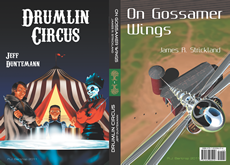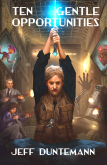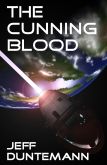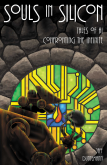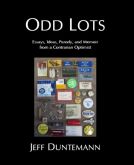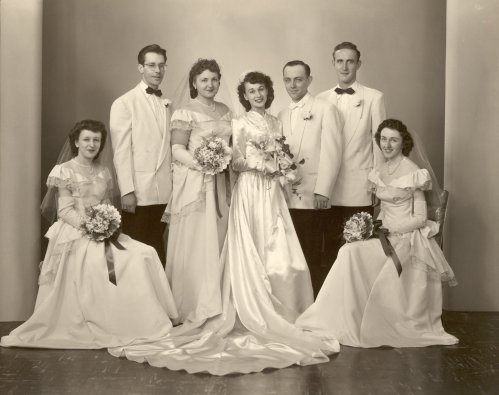 Sixty years ago today, my parents were married, at St. Mary of Perpetual Help church on West 32nd Street in Chicago. It was a remarkable event, not so much because history will consider my parents remarkable (though I do) but because it was, well, unlikely. This remarkableness was not unique, but occurred countless times around America in that era, as social and ethnic barriers that had stood for centuries started to crumble, and men and women began to marry for love and not to satisfy family demands.
Sixty years ago today, my parents were married, at St. Mary of Perpetual Help church on West 32nd Street in Chicago. It was a remarkable event, not so much because history will consider my parents remarkable (though I do) but because it was, well, unlikely. This remarkableness was not unique, but occurred countless times around America in that era, as social and ethnic barriers that had stood for centuries started to crumble, and men and women began to marry for love and not to satisfy family demands.
Consider Frank William Duntemann, the only son of a bank officer at the First National Bank of Chicago. He had been born and raised solidly middle class in East Rogers Park, of a German father and an Irish mother. Hard-headed, ironic, optimistic, stubborn, bright, slightly snotty, and short–5’6″ of solid muscle, fearless and (especially as a young man) a little pugnacious. He drove his parents crazy sometimes, running off to join the Army in 1938 when he was only 16 (the Army sent him home) and getting suspended from Lane Tech for beating the crap out of the six-foot president of the Lane Tech Nazi Society, after the Nazi had made the mistake of stabbing my father in the stomach with a wood chisel during an argument.
And consider Victoria Albina Pryes, the youngest of ten children, born of penniless Polish immigrants in a ramshackle farmhouse in Stanley, Wisconsin. Artistic, fretful, possessed of a beautiful voice, pious to the point of mysticism, and ethereally beautiful, she trained as a nurse in Chicago after WWII and struggled with the question of what to do with her life. Her family thought she should become a nun, because her high-school sweetheart had died in the War, and that could only be a Sign. But she held back, and one day in 1946 a nursing school friend suggested a double date. Mary’s boyfriend knew this interesting guy from the North Side…
Frank was smitten. Victoria was terrified. He asked for her phone number, and in a panic she made something up. Undeterred, the man who had slept through the bombardment of Monte Cassino sent a postcard to her nursing school (we have that postcard) asking her to get in touch. Even though torn between what she felt to be her family and religious obligations and her own infatuation, she did. Not sure what to expect from a man so far removed from her ethnic heritage and socioeconomic class, what she found was passionate friendship. In 1948 he asked her to marry him. By then, there was no hesitation.
But it was not without challenges. Frank’s parents were furious. They had expected him to marry a nice German girl from the neighborhood. Instead, he had chosen a Polock farm girl living in what they considered the slums. Harry Duntemann was not a man to be trifled with, and he told his son to break it off. Harry had managed to browbeat Frank into a bookkeeper’s job that he hated, and was nagging him to return to Northwestern for a degree in business. But the War had changed Frank, as it had changed thousands of men who had been frightened boys the day after Pearl Harbor. Frank took his father aside and told him, “Look, I’ve made my decision and it’s not open to discussion. I’m going to marry Victoria, and then I’m going to Georgia to get my engineering degree on the GI Bill. If you want us to come back here, and if you want to see your grandchildren, you’d better start seeing things my way.”
Harry, perhaps recognizing his own stubbornness in his son, gulped and agreed. (And to ensure that his son would return from Georgia, helped buy him a house–on the North Side.) And so on that gorgeous June day in 1949, my parents made their Happy Beginning, bridging two widely disparate cultures, he confidently, she (as always) apprehensively.
By any measure it was a successful marriage. Frank and Victoria changed one another: He taught her confidence, and persuaded her that she was beautiful and worthy; she taught him moderation and compromise. She was not sure she wanted children, but he did; he was not sure that a gentle style of childrearing would work, but she did. They were in fact spectacular parents. They read to us, they bought us books, they insisted that we speak correctly and tell the stories of our days at the dinner table. My father threatened to call the Alderman if the Chicago Public Library refused to give me a library card for being underage. (I was six; you had to be seven.) I got the card. He gave me money for electronic parts and bought me a microscope; later, when I was deeply into junkbox telescopes, my mother always had a dollar for one more pipe fitting. We were not especially flush, and were taught frugality, but money was always there for things that mattered. Stubborn as he was, my father had the courage to avoid his own father’s mistakes: He told us that no matter what careers we chose, he would support us in that choice.
My father loved my mother fiercely, and the lesson was not lost on me. More than once, when I was sitting at the kitchen table doing my homework, my father came home from work a little early, went up behind my mother at the stove, kissed the top of her head, and told her he loved her. When I was fifteen, he made it explicit: “Love comes out of friendship. If you’re lucky and smart, you’ll marry your best friend.” I did as he said (and also as he did) and no better advice has ever been given to me.
Happy beginnings are often easy. Alas, happy endings are not automatic. I’ve told most of the rest of the story here. In 1968 my father was diagnosed with oral cancer, from his two-pack-a-day habit he had picked up in Italy during the War. He fought back, and it took nine years, but the cancer killed him a piece at a time, in a gruesome progression that still gives me nightmares. It broke his spirit and finally took his mind; at our wedding in 1976 he was weak and confused. By 1977 he no longer knew who I was, which broke my heart, and in January 1978 it was finally over.
My mother was never the same. Living alone in their house for another 18 years allowed her to brood on questions of divine justice that had always haunted her. What had she done to offend God? How had she failed? My mother’s understanding of Catholicism was suffused with peasant superstition amplified to absurdity by her odd mystical personality. It was a cruel and often bizarre religion, full of prophecies and portents and dark powers, overlaid against the looming background of an angry God and an animate Hell. She was tormented by hideous dreams of accusing demons, dreams that may have led (as Gretchen and I have speculated) to the insomnia that plagued her last years. She was literally afraid to sleep, fearing what she might dream. Her doctors tried various drugs, but nothing helped, and even with Gretchen and Bill’s constant companionship and loving care, she lost her ability to speak, and slowly withered away to almost nothing. When I carried her out to Gretchen’s van the day before she died, she may have weighed fifty or sixty pounds, and looked like a victim of the Biafra famine.
It made me furious then, and I still get a little nuts to think about it. How can people who tried so hard, who loved one another so truly and unfailingly, who were generous and industrious and offered their children nothing but unconditional love, suffer such hideous ends? Where’s the justice here? The answers are complex, if in fact they are answers at all, and my readings on theodicy have been scant comfort.
Yes, they deserved a happy ending. And because they never had that happy ending, the day after my mother died in 2000, I sat down and wrote them one. (Warning: Major tearjerker material. The goal was closure, not publication.) They allowed me to be a writer, which is not as secure a career as an engineer (or almost anything else) so it was the least that I could do.
Still, the question stands: Where is the justice? If God does in fact exist, He owes me an answer to that painful question–but if God does in fact exist, (as I think He does) He’s already provided the answer–and the happy ending–to those, like my parents, who are farther along the Great Path than you or I.


 Forty years ago, we watched three human beings travel to the Moon. Well, they got there, and took a spin or two around it, and then came home. They didn’t land, but that’s ok. (Gravity wells are a bitch.) We didn’t appreciate at the time what a feat it was, and would not in fact understand the bittersweet truth for many years thereafter: We had a window; it opened, and it closed. It may not open again—but while it was open, we took it.
Forty years ago, we watched three human beings travel to the Moon. Well, they got there, and took a spin or two around it, and then came home. They didn’t land, but that’s ok. (Gravity wells are a bitch.) We didn’t appreciate at the time what a feat it was, and would not in fact understand the bittersweet truth for many years thereafter: We had a window; it opened, and it closed. It may not open again—but while it was open, we took it.